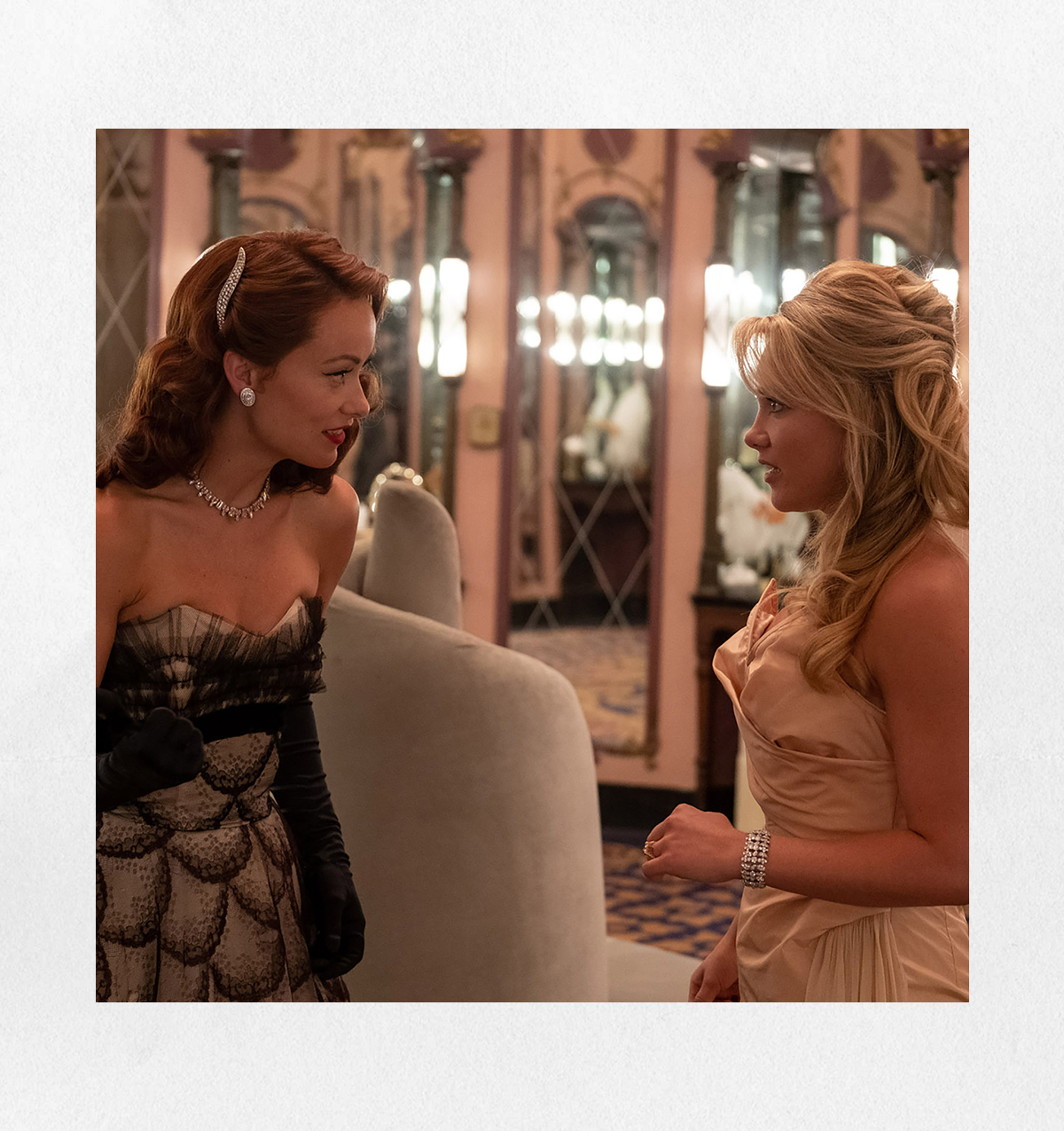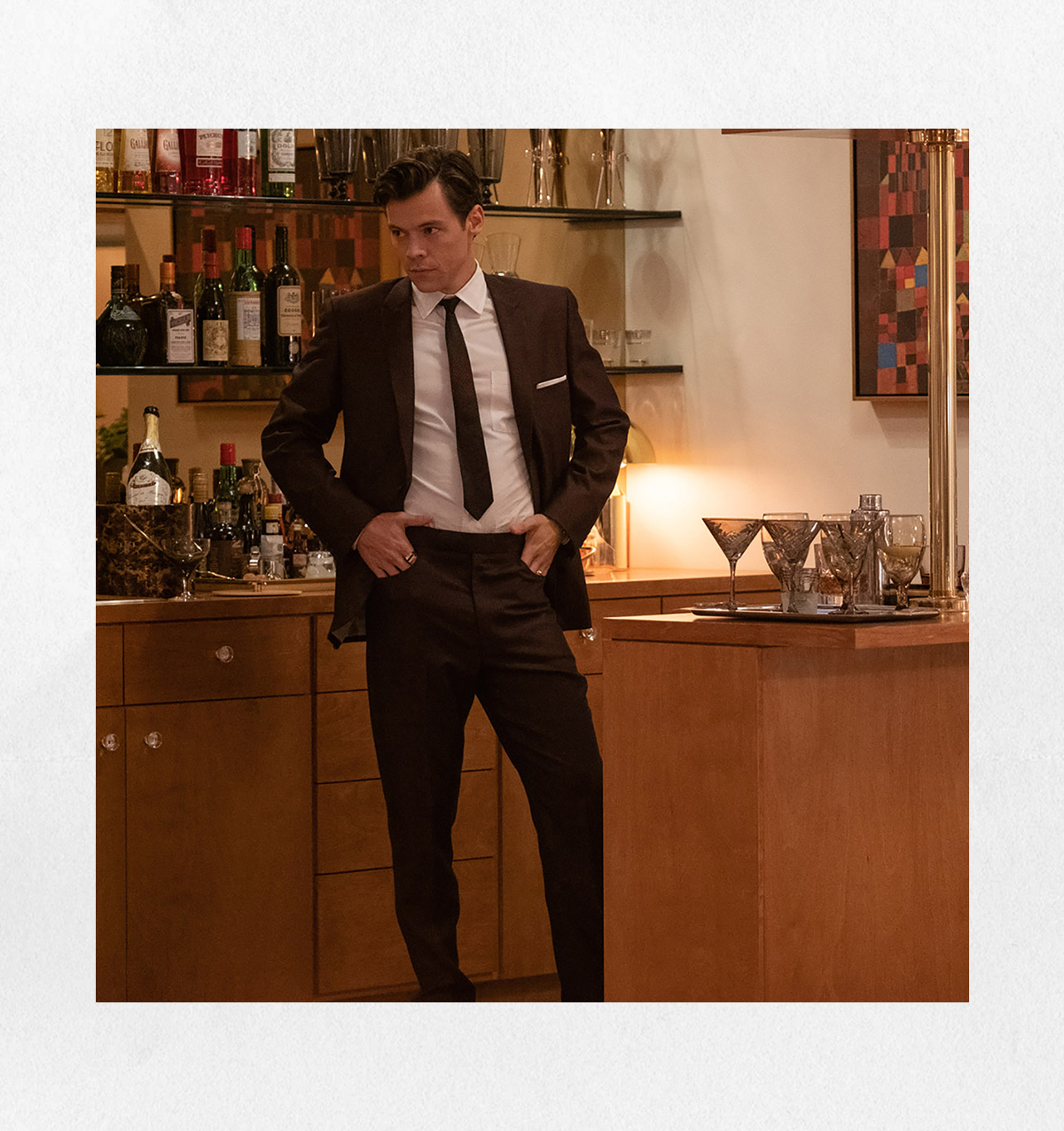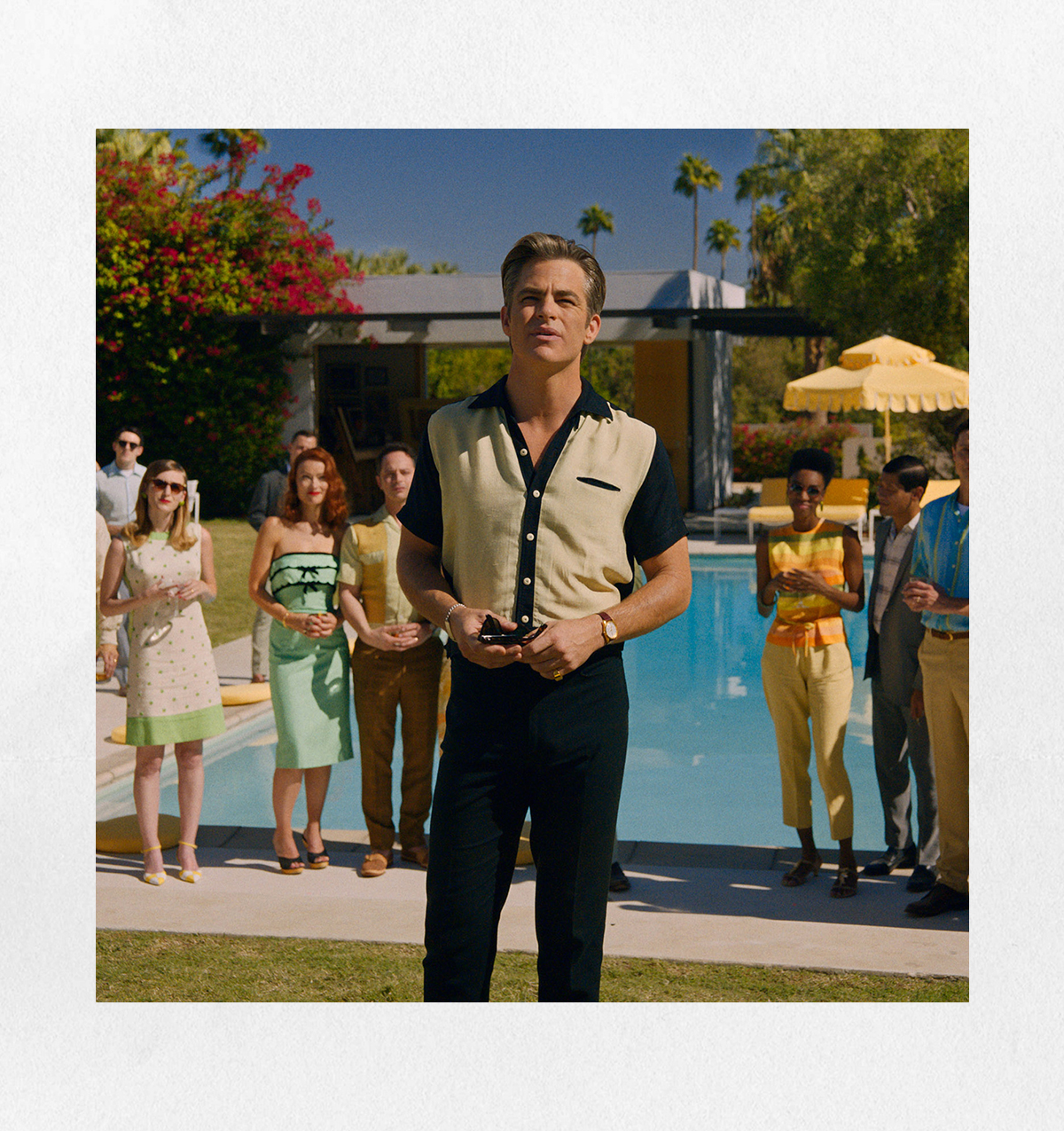Unless you live under a rock or haven’t been online in the past month, the highly anticipated film Don’t Worry Darling has been on your radar one way or another.
The psychological thriller set in the ’50s, which first premiered at Venice Film Festival, follows a couple living in a utopian town called Victory. Upon first glance, the pristine suburban setting is perfect—or seemingly so. When a few of its inhabitants start to question their idyllic life and the Victory Project, no one seems to be able to explain. The fabulous and brilliant Florence Pugh steals the show in more ways than one as Alice Chambers, the inquisitive suburban housewife to Jack Chambers, who is played by Harry Styles.
The film features a star-studded cast and boasts an intensely thrilling story line, but above all else, it is visually stunning. I left the film wanting to re-create every look, and I was mesmerized by the tailored suits, the attention to detail, the retro prints, the colorful sets, and the quintessential imprint that the ’50s and ’60s have left on fashion forever.
In order to convey such a controlled-yet-alluring society of perfection, you have to bring in the best of the best, which is why director and actress Olivia Wilde—who stars as Bunny in the film—called in three-time Oscar-nominated costume designer Arianne Phillips. Prior to Don’t Worry Darling, Phillips worked her magic on iconic films such as Walk the Line, Girl, Interrupted (my personal favorite), and Once Upon a Time in Hollywood.
I had the privilege of chatting with Phillips about her creative process on DWD, from drawing visual references of the ’50s to creating the look for each character. Only she can make a patriarchy-driven yet disturbingly perfect society look as ravishing as it did through her impeccable designs. Not to be dramatic, but the looks were pretty iconic, and I’m almost certain that these costumes will be talked about for decades to come. Oh, and don’t worry, darlings. There are no spoilers ahead.

What were your early conversations with Wilde like when discussing the wardrobe for the film?
I choose to do a script based on who the director is. Every director is different. Most directors are men, and they don’t always have the vernacular to talk about nuance when it comes to clothes and costumes. Costumes are part of the storytelling process in helping develop character, and they help underscore tone and mood. There are so many nuances that we can help underscore in the film, and Olivia as an actress really understands that. She understands the visual cues and the character development but also what a costume can do. When an actor puts it on, it’s almost like it transports them to a different time period. We all know what it’s like to put something vintage on—you actually stand different. In this case, we were using undergarments from the ’50s and ’60s, which affects how the actor moves. … Our conversations were about her visual mood boards. It was a visual document that we would add and subtract as time went on. It started with a lot of visual references, and her references were very sophisticated. It had referenced beautiful photography from the ’50s and ’60s along with references that I knew and loved.
Our early conversations were about how she saw each character and what their motivations were. One of the things I love about Olivia is that she was up for the conversation. A movie like this, we’re making it up. We talked about the music they listened to, the food they ate. We create a full life for these characters, which helps inform me. On top of that, we talked about larger themes like control, a woman’s voice, the patriarchy, and serious themes that ran throughout the film. [We also discussed] what would be beautiful in the way that Matthew Libatique, who is our beautiful cinematographer, was going to light the film.
The conversations were continuous all of the time. They would be in person and on Zoom. All of the conversations in the beginning were on Zoom. We were supposed to start in March 2020, and then COVID hit, but we stayed super connected throughout lockdown. Even with costumes, they thought COVID could be transferred … so we had to figure out elaborate mechanisms of sanitizing them.

As a true lover of vintage, I know that the themes in this time period were bright colors like mint, warm and pastel yellows, turquoise, etc. Alice Chambers, played by Florence Pugh, wore softer colors in the film, such as the beautiful white dress at dinner and the peach dress at the Victory party. On the other hand, Bunny, played by Olivia Wilde, looks bolder, and her looks were quite captivating in the film. What was the inspiration behind the bright color palette? Do you typically enjoy creating costumes for these iconic eras in fashion?
Walk the Line was a biopic, and this movie wasn’t real. With this film, we got to take a cinematic license. It was an idyllic community, Victory. We shot exteriors in California with the beautiful light, so I wanted to lean into color. I wanted to be sparingly into color. Colors are great for setting a time period. It takes place in the early ’50s and ’60s, which is a changing time.

How did the mindset/attitudes of each of the characters influence their wardrobe choices?
Bunny’s character is more ’50s, and that was because she loves Victory. She’s totally invested in living there. Alice is forward-thinking and more in the ’60s. I wanted to design the film for a contemporary eye. I wanted the audience to live the dream as well, and I wanted to make it about pieces that had relevance today. For instance, Jack’s suits. A lot of the costumes would look [as] chic today as they did then, and that was pretty purposeful. I wanted the audience to be seduced by Victory as well.

The film is set and filmed in Palm Springs, and it reflects an idyllic environment with perfect housewives and perfect husbands. What was your process of reflecting that environment at all times in the film through the costumes?
It was in the script for sure, and it was looking at these larger things like control and patriarchy. It was looking at these larger stories and the patriarchy and when women had societal norms. In different cultures, this still exists, where women’s voices take a back seat to a patriarchal society. The way the women are dressed and the way the men dress themselves is through a male gaze. We looked at the Rat Pack era and Frank Sinatra and Sammy Davis Jr., and you can see it reflected in that crisp, clean look that’s pretty desirable. The women in Victory are glamorous at all times by doing housework and looking gorgeous, which is unrealistic. This is when the gender norms were binary. That was something that was normal for our grandparents, so this is a concept in the script that we can show through the costumes.

How much time did you have to prepare all of the styles/outfits for DWD? What did the creative process look like for you? How much of the clothes were sourced from vintage and prop houses vs. designed for the film?
Because it was a challenging time with COVID, all of my normal resources weren’t available for me. I usually source vintage from a list of people nationally and internationally, but during COVID, a lot of places were closed. We would set up our own flea markets here in Los Angeles, and there, vintage dealers were set up outside. A lot of the inspiration came from real vintage, and I sourced a lot of vintage fashion for Jack’s suits and Alice’s dresses. Two-thirds of their costumes were built and designed, and a portion were vintage and sourced. For the most part, I made things for certain background actors, like the shopping scenes, and there are scenes that don’t make the cut.

The ladies in the film truly stole the show and delivered remarkable performances. Jack Chambers, played by Harry Styles, was also very likable, but I’m still thinking about how great he looked in every outfit. I couldn’t help but notice the detail in all of Jack’s looks, from the bowling shirts to tailor-made suits. His looks among the rest were absolutely perfect and fitting, especially the blue/black cardigan with the trousers (loved it). I feel like he would even wear that ’fit in real life. How was it working on Styles’s looks throughout the transitions of the film? How involved was Styles in terms of building out Jack’s look?
Harry was a dream to work with. He was very open and generous with the time he gave to the multiple fittings, as there were quite a few costume changes. In our first meeting, which was on Zoom, I shared images from my character book I had made for Jack, and we spoke about the overall tone and feeling of the film. Oftentimes, an actor’s "entry” into the film is via a costume fitting, which usually precedes rehearsals and the camera tests.

Frank, played by the one and only Chris Pine, was the boss and the leader of the mysterious company. His presence ignited fear in his employees even though his looks were more casual than the other characters. How were you able to convey that with his costumes in the film? I feel like the blouse in menswear is making a comeback. Do you see casual menswear making a comeback?
Chris was a lot of fun to collaborate with. He had thought a lot about his character and how he would dress. We had some really lively and fun conversations around the choices we would make for his character. Chris wanted Frank to be barefoot at home at his party, which is really something that would have been highly unusual at the time, but I loved it as a character choice, and it really felt like something Frank would have done that was just a little "off” and, at the same time, unnerving to his guests. We do see him at leisure at home, but we also see him in a cocktail suit when he and Shelly come to Alice and Jack’s for dinner and, of course, his formal white-dinner-jacket look at the party. We had ample opportunity to really dive into Frank and his many different looks.
Don’t Worry Darling is in theaters on September 23.